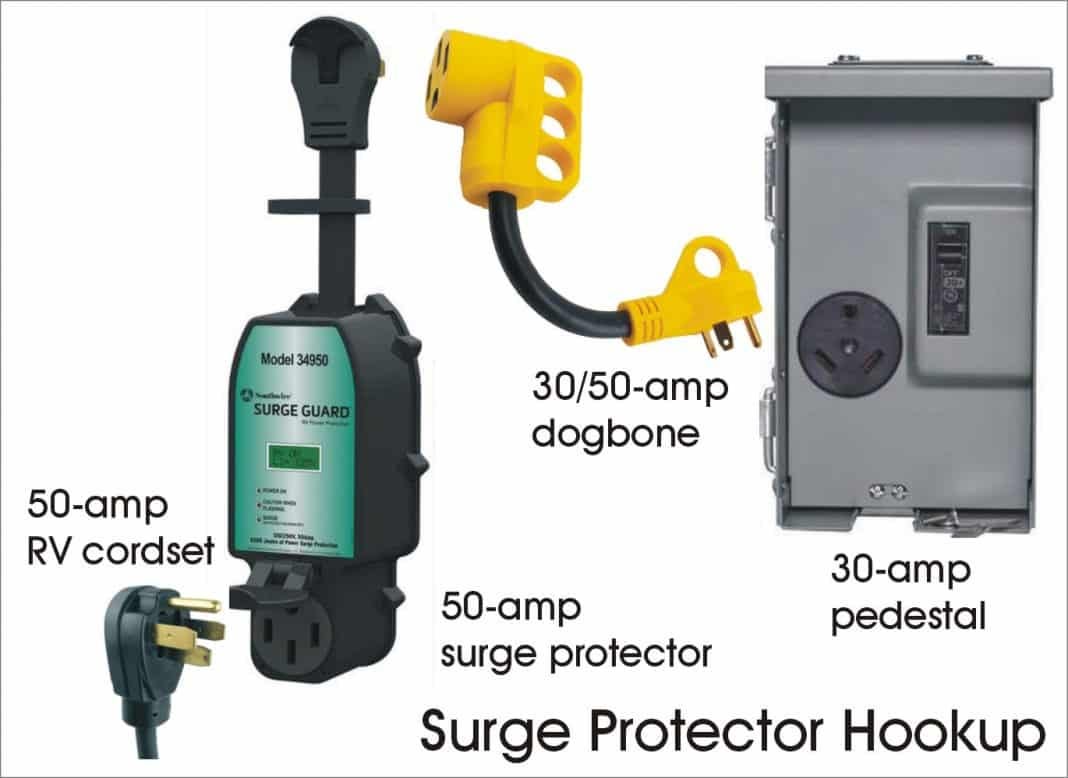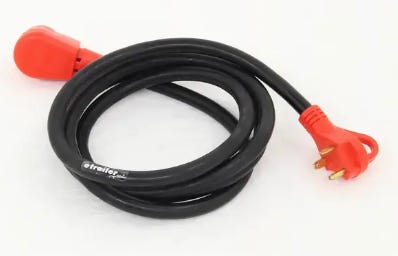Selecting the right size surge protector
Do you need a 30-amp surge protector to plug your 50-amp RV into a 30-amp pedestal?
From the No~Shock~Zone
Q: Hey Mike,
We have a 50-amp RV and purchased a 50-amp surge protector (yup, we are listening to you). We frequently stay at 30-amp-only campgrounds and want to keep electrically safe. Right now we connect a 30/50 dog-bone adapter to the pedestal, then the 50-amp surge protector, and finally our RV’s 50-amp power cord. Is this the best way to hook everything up to protect our RV from electrical problems? Thanks. —Joni and Roger W.
A. Joni and Roger,
Yes, I’ve discussed this with Surge Guard engineering, and the consensus is that the size of the surge protector should match the shore power cord (and amperage) of the RV itself. So if you have a 50-amp shore power cord on your RV, you should get a 50-amp surge protector. If you have 30-amp RV with a 30-amp shore power cord, then you need a 30-amp Surge Protector.
As you can see from the diagram below, when your 50-amp RV meets a 30-amp pedestal you plug a 30/50-amp dogbone adapter into the pedestal outlet, plug your 50-amp Surge Protector into the 50-amp outlet on the dogbone adapter, and plug your RV’s 50-amp shore power cord into the Surge Protector.
What about plugging a 30-amp RV into a 20-amp outlet?
Of course, if you have a 30-amp shore power cord on your RV, you should get a 30-amp surge protector. If you then need to connect it to a 20-amp outlet, use a 15 to 30-amp dogbone adapter to connect your surge protector.
It’s a keying thing
Remember that you can insert a 15-amp male plug into a 20-amp outlet, but you can’t connect a 20-amp male plug into a 15-amp outlet. It’s a keying thing with one of the blades turned sideways. And since both types of connectors are rated for 20-amps, a properly built 15-to-30 amp dogbone adapter is actually rated for 20-amps of load current.
(Don’t) Get down in the mud
What if your Surge Protector is sitting down in the mud? I use a 10-ft TT-30 male to female extension cord to allow the surge protector to be strapped to the side of the pedestal with a short piece of rope or tie-line.
While I typically don’t like to add any more electrical connectors than actually needed, you really don’t want your surge protector laying down on the ground where it can be sitting in a puddle of water. It’s not only bad for the electronics in the surge protector, an electrical outlet sitting in the puddle of water can energize the water itself and shock you if you step into it.
I’ve also used an upside-down bucket in a pinch to hold the surge protector off the wet ground, but I really don’t like bending the surge protector cord since it puts a lot of strain on the TT-30 plug which can easily be pulled out ot the receptacle. That’s why I keep a 10ft extension cord in my RV pack.
Where to buy surge protectors (and lots of other RV stuff).
I’ve just started an affiliate program with TechnoRV which does pay me a small commission on products that you purchase from them. I’ve know Eric and Tami for years, and their customer service and educational programs are fantastic. That’s something you don’t get from Amazon or eBay (as much as I like both of them). So click the TechnoRV logo above and take a look around. Many of their products were independently reviewed by me before they became dealers for them.For a direct link click HERE.
Yes, I am both RVelectricity AND No~Shock~Zone!
And yes, I am also that No~Shock~Zone guy, so I’ll be republishing many of my NSZ articles here as well. I write a lot of stuff!










If I already have a good 50A surge protector and now have a 30A MH do I have to buy a 30A surge protector?
Mark Carrow
we did test the plug - I had shown him the diagram you sent, also had the multi meter you advised I buy, and he had his own as well. We tested the wiring. I don't know if it is best to buy the surge protector from the dealer - will call him this morning. I have messaged Techno RV about their gas stop product and looked at their surge protectors on their web site.